Forward and backwards, left and right, up and down are the six co-ordinates. Yin and Yang, rise and Fall, Movement and stillness are the six co-ordinates. Jing, Qi and Shen, Eyes, Limbs and Body are the 6 co-ordinates. Wrists and ankles, knees and elbows, shoulders and hips are the 6 co-ordinates.
The Liuhe (六合 Six Harmonies) are a key to many traditional Chinese martial arts. However in the North of China amongst the Huizu (Chinese Moslem) community a thorough martial art system which is centuries old is practiced that allows the mastery of the perfect harmony and the achievement of excellent combat skills and effectiveness. It is one of the older martial arts and is thought to have influenced many others styles in the Central Plains.
History and Development of Liuhe Quan
There are many legends to the origin of Liuhequan (六合拳 Six Harmonies Boxing), some suggest that it was a faction of the Shaolin school or Liuhe branch, Shaolin Weituomen, Shaolin Yupai (少林韦陀门). This is was mainly propagated by Wan Laisheng, a famous Liuheziranmen practioner. Another legend is that it original from ancient moslem methods where the Liuhe are actual references to the Huizu headwear. Thirdly, it is said that Yuefei, had developed the essentials of the style Liuhequan and Liuheqiang (Spear) in the Song dynasty which he taught senior members of his army. This is mainly as a result of the famous text Liuhequanxu (Preface to Liuhequan) which is a part of the Xinyi tradition.
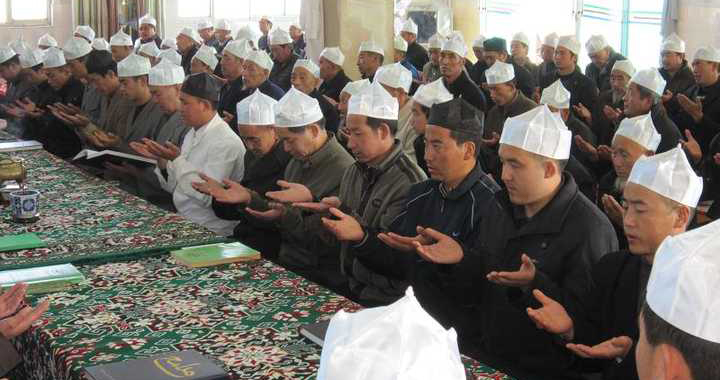
The ancient ancestry of Liuhe Quan is centred on the early Huizu but history has had many impacts on their evolution. In the Ming Dynasty, when Ming Taizu Zhu Yuanzhang ascended the throne he prohibited many practices however he promoted the use of the “Liuheyi unified, 六合一统帽” head cover. Zhu Yuanzhang wrote that “the world is peaceful and the Liuhe are unified, 天下平定,六合归一”. Actually this tradition has a very meaningful origin where the holy Quran contains: “Allah created the heavens and earth and everything in six days, and then corrected Alshi.” Alshi is six sides and six directions, which is Liuhe. In the past Cangzhou all wore hexagonal hats (not the dome hats which are popular today, over time different fashions evolved). The hexagonal or Liuhe hat therefore represents the original practitioners and a concept for Liuhe Quan, which itself represents the universe in harmony.
What is a key irrespective of legend is that the primary concept of six co-ordinations/harmonies that is essential to the style is common and critical element in many martial arts. In its simplest concept this refers to The Nei Wai San He (Internal 3 and External 3 Coordinates), 3 Internal are Xin, Yi and Qi and the 3 External are Hands/Legs, Elbows/Knees and Shoulder/Hip. So Xin and Yi coordinate, Yi & Qi Coordinate, Qi and Li Coordinate. Externally Hands and Legs coordinate, Elbows and Knees Coordinate and Shoulders coordinate with Hips. The Internal and External Combine into one (Nei Wai He Yi), this then is Liuhe.
Liuhequan is considered an ancient martial art, the earliest records however date to the Ming dynasty. A famous warrior Zhang Ming (张明) passed through Qingzhen Balizhuang in Botou village, Hebei Province, when he collapsed as he was injured and had been ill. Cao Zhenpeng (曹振朋), a huizu (chinese moslem) took the injured warrior into his home and gave him medical attention. As a result Zhang Ming was indebted and passed his martial arts skills to Cao Zhenpeng. Master Zhang would watch how diligent and ardiously every morning Cao Zhengpeng practised and was impressed by his dedication and development that he also passed on all his boxing and martial skills, including boxing manuals to him. The art was Liuhequan.
Cao Zhenpeng only taught his son Cao Sheng who in turn passed the art to Li Guanming, Shi Jinke, Shi Changchun and Zhang Maolong. Since the great master Zhang Ming made a point of advising Cao Zhenpeng not to transmit the art easily, It is only in the fourth generation that the art commenced being taught to others.
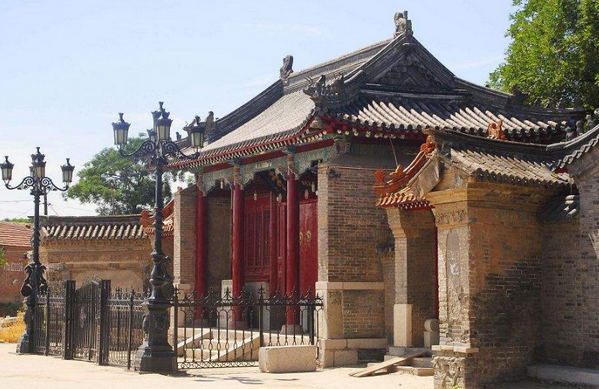
Shi Jinke taught around 18-20 disciples, who all became well known in the martial world. These include “Heixunfengshenliqianjinwang” (Black tornado Spirited, Strength of 1000 Catties King) Shi Jinsheng. Others included Shi Jinhe, Chu Wentai, Shi Qingzhen and Tian Kechun. Since Liuhequan emphasises the three methods of strike, lock and throw, many Liuhe masters became well known for their Shuajiao (Chinese Takedowns and Wrestling) skills and have instrumental in the development of Shuaijiao.
The original place of concentration and practice is in Botou City, Hebei Province south of Cang County. Mainly inherited by the large Chinese moslem community, it used to be taught with the Huizu Mosque and amongst villagers. Through generations the art has been improved on and developed. Since Shi Jinke was so important in the propagation of the art often Botou Liuhequan is referred to as Shi Family Liuhequan.
Li Guanming, a Hui from Cangzhou, was an expert of Tantui Men and other boxing methods before studying in Botou under Cao Sheng. Li absorbed many great techniques from the Cangzhou region including styles such as Chahua, Guangdong, Guanxi, Hongquan and specialized weapons such as Qingping Sword from M. Yang En’lin. Li became extremely capable and his Biaoju (Security Logistics Bureau) known as Chengxing Biaoju became both the most respected and the most feared in Cangzhou. In fact there is a famous saying that all Security Bureau’s would have to drop their flags when passing Cangzhou. Whilst commonly told because Cangzhou was home to so many martial arts experts that one should be humble. However, the real legend relates to Li Guanming and his feats of strength, his amazing combat and weaponry skills, the power of his Chengxing Biaoju and the skills of his inheritors. It because of Cangzhou Da Liuhe Men’s founder, Li Guanming that Cangzhou became so renowned.
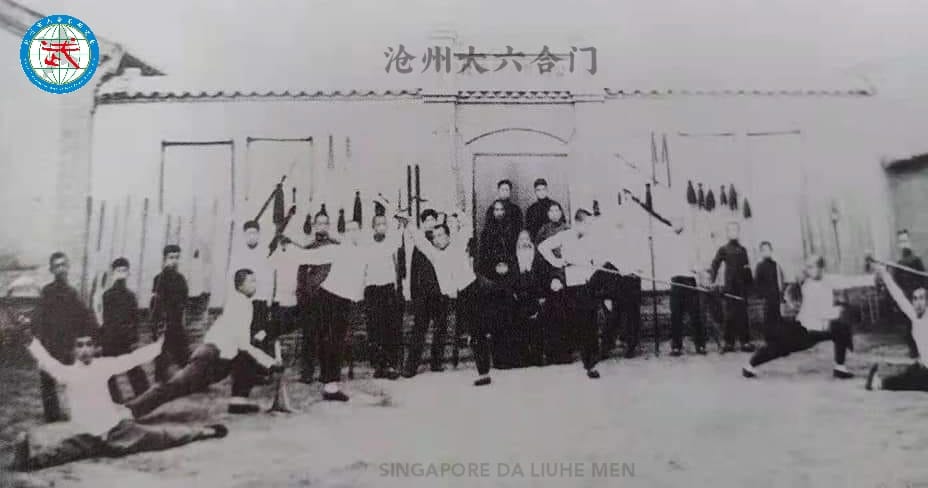
A well known master Liu Dekuan, was originally from Cangzhou. studied Liuhequan with Tian Chunkui and Li Fenggang (Li Guangming’s nephew). Later he taught various disciples taught in Beijing including Zhao Jinzhou, Xu Wansheng (1878-1945), Wu Junshan and Li Yongzhu. Practitioners evolved Liu’s teachings to formulate the Beijing Liuhequan school. Since Master Wan Lai Sheng was a well known master of Ziranmen his descendants mostly from Fujian, are often recognized majorily for their Ziranmen. Ziranmen Liuhequan being a derivative of Beijing Liuhequan implies that it is also part of the modified Liuhequan as developed by Master Liu Dekuan. Master Wan Laisheng, became famous many years ago in 1928, through his activities and actions associated with the Central Guoshu Institute of Nanjing, thereafter he was sent to South China (Fuzhou, Fujian Province) to assist in the teaching and development of martial arts.
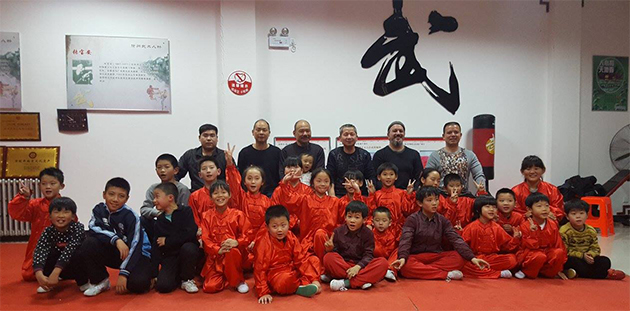
Li Shuting (1863-1939) studied with Li Guanming’s disciple Wang Dianchen and later also received instruction from Li Fenggang. Li Shuting’s disciples included Hu Yuntian, Zhang Fengshan, Zhang Dieshan, Liu Yunting, Wang Shaofu, Li Baode, Wang Zixiang, Zhang Baochang, Zhang Zhenjiang, as well as his son Li Zhiyun. Li Shuting was also the first teacher of well known M. Wang Ziping becoming his disciple in 1910. Li Zhiyun (1910-1984) was the son of Li Shuting, he had lived through a lot of turmoil in China and was able to preserve much of Da Liuhe Men. Li Zhiyun taught disciples including Zhang Shaofu, Li Jinrong, Ma Honglin, Zhao Guangdi, Zhang Yingjie, Ma Zhenzhi, Li Hongsi, Wu Jinming, Zhang Kaisheng, Wang Junxiang, Yin Guangpu, Li Baosheng, Yang Liyuan, Wang Youdong, Ma Shuangwei, Zhang Wenzhong, Xiao Wenxu, Wang Wencan and taught his son Li Junde (1960-), the current generation keeper of the style.

Another well known master of Liuhequan was the great Tong Zhongyi (1879-1963), Manchurian from Cangzhou, Hebei province, who defeated Sichuan Master Wu Shaoji at the Nanjing All China Guoshu meet. He later became well known and taught in Shanghai. Tong Zhongyi had studied with his father, a disciple of Tian Kechun. Regarded as Shanghai Liuhequan, the style has become popular with many practitioners including his early disciples in Cangzhou such as Guan Wenquan, Guan Jixiang and Zhao Yongfu. Master Tong’s family especially his daughter Tong Peiyun (who later moved to Singapore), Tong Jiayi (Taiwan),Tong Jiajun, and Tong Jialu (Shanghai). Also his son in law (Tong Jiayi’s husband), Li Yuanzhi (Taiwan) and his main disciples in Shanghai included Liu Fei and Yu Fengyi as well as those general students from his school in Shanghai. Some practiced specific skills (like Shuai Jiao wrestling) or aspects, rather than the whole Liuhe Men System.
Cangzhou Liuhequan (沧州大六合门 Da Liuhe Men) – This branch is the one which made Liuhequan famous as many great Masters were from this lineage. This branch was later to be known as Da Liuhe (Great Liuhe) both because it’s origin with the founder studying in Dachu village, and later since its masters would learn from other styles making the system larger, whilst also resulting status in the martial world at the time
. This branch is from the descendants of Li Guanming whom had first mastered Dachu Tantui Me, then Botou Liuhe Men, Qingping sword and other systems. It includes notables such as Li Fenggang, Wang Zhenyi (Da Dao Wang Wu), Liu Dekuan, Tong Zhongyi, Wang Ziping and Li Shuting.
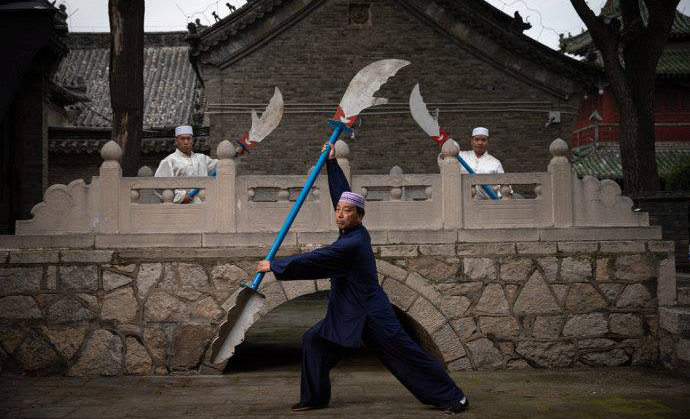
Botou Liuhequan (泊头六合拳 Liuhe Quan) – This is branch in which the decendants of Shi Family (5th Generation Shi Jinsheng) continue their practice. Both Botou Liuhequan and Cangzhou Liuhequan have similar content in terms of the respective routines and practices, However, Cangzhou Liuhequan includes a lot more material, as during the Biaoshi (Security Logistics/Bodyguard services) times, practitioners would absorb skills from around the region.
Beijing Liuhequan (京师六合拳 Jingshi Liuhe Quan) – This branch is from the descendants of 7th Generation M Liu Dekuan. M Liu studied many martial arts and re-organized Liuhequan into simpler concise routines. His descendants thereafter practice a unique type of Liuhequan, referred to as Beijing or Jingshi Liuhequan today. Another descendant of the Beijing branch includes Wan Laisheng, best known for his Ziran Men, Wan Laisheng also re-constructed the forms and contents of Liuhequan and taught in the South of China (Fuzhou). Thus this sub branch of Beijing Liuhequan, is today referred to as Fuzhou Liuhequan (少林六合门), or ZiranMen Liuhequan (自然六合门).
Liuhequan is characterised by very clear and defined movements, where there is change but the points of pause and action are clearly divided. The postures are interconnected and the applications straightforward. Liuhequan aims to combine the internal with the external in a balanced harmonious and mutually supportive manner. Taiping Liuhequan is comprehensive including a number of Liuhequan family styles (Cangzhou Da Liuhe Men, Tong Style Liuhe Men, Jingshi Liuhe Men).
The 6 Harmonies of direction: North, South, West, East, Up and down. The 6 Harmonies of the parts: Hands, feet, elbows, knees, hip and shoulders. And so on. In basic skills development Liuhequan concentrates on the 5 skills of Zhuang (Stance), Yao (Waist), Tui (Legs), Zhang (Palms) and Qi (Underlying energy).
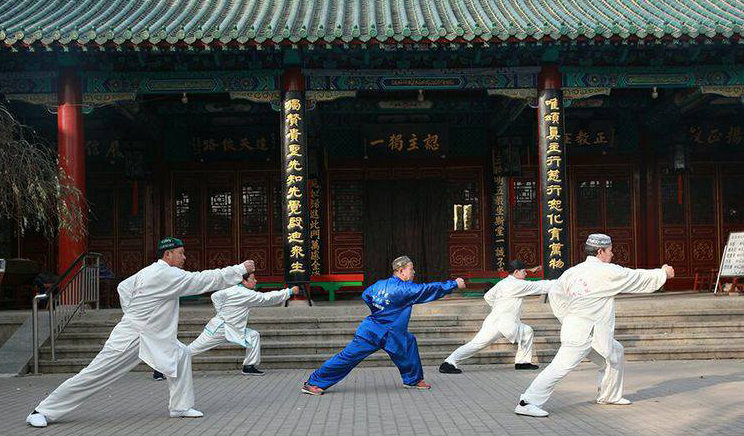
In combat it is said ‘Once the hands are released then they will strike, if the hands must be retracted the will grab, yet should the hands be lockup up then they will throw, whilst once the legs rise they will kick:” (出手便打,顺手便拿,缩手便摔,起脚便踢) Thus we emphasize:
- Ti (Kick)
- Da (Strike)
- Na (Grab/lock)
- Shuai (Throw)
Therefore in principle every strike can be followed by Chi-na techniques and thereafter by a throw. The development of combat then concentrates on the Bamu (8 roots) of : Ti (kick), Da (Strike), Shuai (Throw), Ji (Hit/beat), Qin (Sieze), Na (Grab), Xie (Take out) and Dian (Press).
Watching in the 6 aspects and fighting in the 8 directions, calmness externally with pure intention internally, the liuhequan practitioner can succeed. Given Liuhequan’s combat approach, the practice is comprised of 3 main components :
- Structure
- Strength & Locking
- Throwing & Wrestling
To develop structure, students are required to practice basic movements, Liuhequan is very structured so that Tantui prepare a very good foundation upon which students can build their skills. Tantui is comprised of rows of simple combinations that are repeated, this repetitive process develops both the strength, stamina, coordination and structure required for the further aspects of Liuhequan.
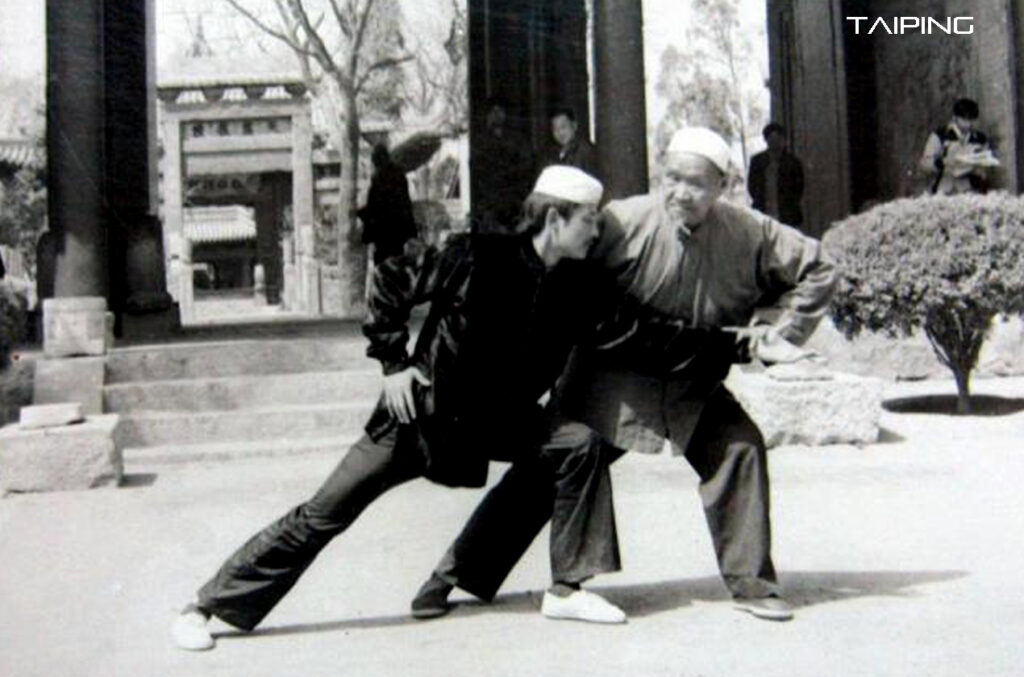
Whilst developing structure and learning the basic methods of Striking (including all parts of the body, legs, knees, hips, back, elbows, hands, head etc…), students also commence the various Shuajiao exercises including stepping methods, various grappling and hand trappings, body and back strengthening, methods of entry, basic throws, lead throws, captured throws, deceived throws, and reverse throws. This then leads to combinations practices, sparring and combat. Concurrently students learn methods of evasiveness, agility and striking, many combinations form small 2 man drills and coordination methods which eventually lead to full 2 man combat set practice, applications free practice and open combat.
Grappling is developed by various exercises followed by the development of grappling alertness so that the practice of Chin-na becomes logical and natural, from the basic self defense grabs to the advanced breaking, limb destruction and artery sealing grabs. This then leads to the practice of two man combat sets designed with many Chin-na methods within and the development of Fan Chin-na (Reverse/Counter Chin-na). The latter stages is when students combine their striking abilities with their locking and throwing ones. The result is a complete and fully capable martial artist which by coordinating all aspects of the body, success in Liuhequan would result.
Foundation
In Liuhequan some of the earlier forms are simple comprising of few techniques repeated in rows to enforce good technique, strength and structure. Students would often commence with Tantui, liutui Shi and Zaquan before Liuhequan. Progressing to the more advanced methods in time. Combat and associated strength training is as per the methodology and are concurrently addressed. Applications are practiced via the many two man forms and by other drills and free combat methods applicable to the style. Such combat includes the use of striking, kicking, locking/grappling and throwing.
| 六合弹腿 6 Harmonies Spring Kicks 封接弹腿 Dual set of Spring Kicks | 砸捶一路 (前) Hammering Strikes 1 砸捶二路 (后) Hammering Strikes 2 | 遛腿势 elongated kicks 六路短拳 Tantui Short Strikes |
The core consists of the key methods of Liuhe Men including Liuhe Quan and Pao Chui.
| 六合拳一路 (前) Six Harmonies Fist 1 六合拳二路 (后) Six Harmonies Fist 2 行门八式 Moving Gates Eight Postures 八拆拳 8 Dismantles Boxing | 六合短捶 Short Strikes 五花炮 5 Cannons 烈伸拳 Strengthen & Stretch Boxing 梅花拳 Plum Blossom Boxing | 迎门炮捶一路 (前) Cannon Boxing 1 迎门炮捶二路 (后) Cannon Boxing 2 回龙拳 Dragon Boxing 六家势 6 Families Postures |
There are also other sets that are both the transformation of Liuhe methods (e.g. Xing – moving and continuous) and new techniques, either from experiences or practices of other martial arts. Many of these have also been influenced by other Cangzhou martial arts including Yanqing Quan, Taizu Quan, Chahua Quan, Dahongquan, Tantui, Guangdong Quan and Tang Quan as examples (and those styles by Liuhequan). However, the practice method and power are all in the manner held by the principles of Liuhe Quan.
| 小洪拳 Small Hong Fist 万寿拳 Longevity Fist 少林拳 Shaolin Fist 太祖拳 Taizu Boxing 二郎拳 Erlang Boxing 金刚拳, Warrior Guard Fist | 连环拳 Continuous Boxing 关东拳 Passing the East Boxing 劈挂拳 Old Pigua Boxing 截打拳 intercepting strikes boxing 关西拳 Passing the West Boxing 醉八仙拳 8 Immortals Boxing | 三十六大招行拳 Moving 36 Major skills Boxing 行八勢 8 Patterns 六家行拳 Six Postures continuous 旋风行掌 Moving Whirlwind Palms 梅花八步行拳 Moving Plum Blossom Changing 黑虎拳 Black Tiger Boxing |
There are various internal cultivation methods within Liuhe Quan as well, mostly of the Daoist Schools such as:
| 十三太保 13 Taibao Gong | 化功拳 Skill Transformation | 五禽戏 Five Animal Play |
Although there are many more drills and sub 2 man routines in Liuhequan, these are the specific sets which develop various specialties of combat development.
| 連手 對練 Continuous Hands 勾手 對練 Hooking Hands 点手 對練 Point Striking Hands | 拷打 對練 Beating Hands 捋手 對練 leading Hands 滑手 對練 Sliding Hands | 擒拿手 對練 Locking Hands 摔技法* Throwing (Wrestling) Hands |
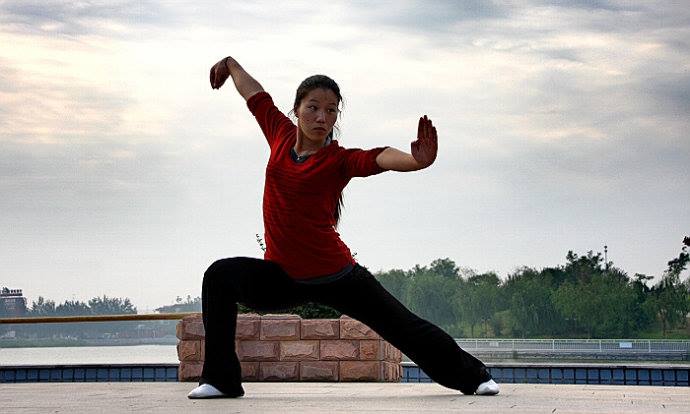
Within the Daoist circles, the sword originally a ceremonial tool was often carried by wandering Daoists. Over time techniques with the sword started to become develop through experiences. The Qingping (Water Lily) sword was mentioned within poetry since ancient times such as the Eastern Han Dynasty (25-220). However it was said to have been developed into the system we know today by a Daoist from the Dragon Tiger Mountain (Longhu Mt in Jiangxi Province which became the home of Zhengyi Daoism in the past). Daoist Pan Zhenren had studied sword methods with his predecessors. Later through his experiences in combat and through his opponents collected various methods and compiled them as Qingping Sword. Pan was said to have passed to Meng Jiaohua (孟教华) who was from Yishui county in Shandong province. Meng then taught his skills to Feng Xiyang who was from Linyi, Dezhou county (which is far in the west of Shandong, close to Hebei Cangzhou). Feng Xiyang taught Yang En’lin who was from Wuding Mansion (today Shandong Binzhou Huimin County). Yang En’lin was martial artists and involved in number of revolutionary activities that were being conducted from the greater Dezhou area. Yang originally an expert of the spear, became the key inheritor of Qingping Sword. Yang compiled his martial arts into a manual known as the Qingping sword manual 1856 which outlines his teachings at the time. Yang En’lin is said to have taught his cousin from the same village Liu Huancai, a Tongbi Pigua M. Jia Yunhe, a Da Liuhemen M. Li Guanming, Yang Yunqiao, Ma Yunqi and Gao Heling.
Li Guanming (~1783-1863) was from Cangzhou, the head of the Chengxing Biaoju (Chengxing Security Logistics), expert of Tantui, liuhequan and other boxing systems. The founder of the Cangzhou Da Liuhe Men system. Li was a righteous hero of the Hui Minority, renowned for his superb martial skills he was not only undefeated throughout life but also the Master responsible for Cangzhou receiving its renowned ‘do not raise your flags’ rule when passing Cangzhou.
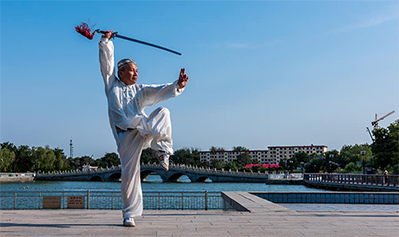
Li’s reputation with the Liuhe Spear and the broadsword were renowned. After helping Yang En’lin with some bandits in his old age, Yang En’lin taught Li the complete Qingping system including the Qingping Sword, Zixu Spear and Chunyang Dual Sword. Yang’s hand written manual (dated 1856) was also passed onto the Li family. Li and his students learnt the old Qingping sword which consists of 175 methods in Six Sequences.
Sometimes this is referred to Yang (En’lin) Style Qingping sword, but normally it is just Qingping Sword. This Qingping sword was passed down in the Cangzhou Li Family – Li Shuting-Li Zhiyun and the current 9th generation keeper of the sword system, M Li Junde.
Yang Style Qingping Jian (杨氏青萍剑 (一至六路) Qingping Sword)
Chunyang Jian (纯阳对剑 (一至十二路) Chunyang 2 man Duel Sword)
Zi Xu Spear (子婿枪(一至六路) General Zi Xu Spear )
Due to the importance of defending and protecting goods through the security bureau, the Da Liuhe Men officers would be trained in a large array of weapons. This has led to over 50 different types of weapons, we list some of the most important ones. Although Liuhe is famous for the Liuhe Saber and the Liuhe Spear which are the largest system of training those weapons among any style in the world. The Liuhe Long Spear is especially well renowned. In addition by the inclusion of the Qingping Sword system, Liuhe also has a vast system of sword as well.
Broadsword
| 六合刀一路 (前) 6 Harmonies Saber 六合刀二路 (后) 6 Harmonies Saber 六合玲珑刀, 6 Harmonies Exquisite Saber 六合行刀 , 6 Harmonies Moving Saber 六合双刀 6 Harmonies Double Saber | 十二连环刀 12 Continuous Saber 金背连环刀 Gold Back Continuous Saber 拔步连环刀 Odd Step Continuous Saber 如意连环刀 Ruyi Continuous Saber 风目连环刀 Tornado Eye Saber | 六合砍刀 6 Harmonies Chopping Broadsword 六合战刀, Long Battle Saber 六合朴刀 Long Handled Broadsword 春秋大刀 Spring Autumn Long Handled Saber 三尖两刃刀 three pointed long handled saber |
Sword
| Baxian Jian (六合八仙剑 8 Immortals Sword) Kun Wu Jian (昆吾剑 Kwun Wu Sword) | Wuxing Jian (五行剑 5 Moving Sword) Liuhe Shuang Jian (六合双剑 6 Harmonies Twin Swords) | Qingping Jian 杨氏青萍剑 (一至六路) Qingping Sword Chunyang Jian (纯阳对剑 (一至十二路) Chunyang Sword) |
Spear
| Meihua Qiang (梅花枪 Plum Blossom Spear) Zi Xu Qiang (子婿枪(一至六路) General Zi Xu Spear ) Liuhe Jiazi Qiang (六合架子枪 (一至六路) 6 Harmonies Jiazi Spear) | Liuhe Yuejia Qiang (岳家枪 Yue Family Spear) Liuhe Qiang (六合花枪 (前/后)) 6 Harmonies Spear) Liuhe Xing Qiang (六合行枪 (一至六路) 6 Harmonies Moving Spear) | Shuang Tou Qiang (六合双头枪 Double Headed long Spear) Shuang Qiang (六合双枪 Double ended short spears) Liuhe Da Qiang (六合大枪 6 Harmonies Long Spear) |
Other
| Liuhe Gun (六合棍 Six Harmonies Staff) Xingzhe Gun (行者棍 Wanderer’s Staff) Duan Gun (短棍/鞭杆 Short Stick) Hu Shou Shuang Gou (护手双钩 Guard Hand Double Hook Swords) Sun Bin Guai (孙膑拐 Sun Bin’s Crutch) Liuhe Shuang Chui (六合双锤 Double Hammers) Chen Xiang Guai (沉香拐 Agarwood Crutch) San Jie Gun (三节棍 3 Sectional Staff) | Liuhe Shuang Goulian Qiang (雙鉤鐮槍 Double Hook Spears) Shuang Fu (双斧 Double Axes) Liuhe Yueya Yue (六合月牙雙钺, Moon Hooks) Liuhe Meihua Yue (梅花雙越 Plum Blossom Crescent Blades) Shuang Shaozi Gun 双梢子棍, Double Section Staff) Shuang Huan (双环 Double Rings) | Liuhe Fengchi Tang (六合风翅镗 Phoenix Wings Rake) Liuhe Fang Tian Hua Ji (方天画戟 Halberd) Liuhe Qinglong Ji (青龙戟 Single Moon Crescent Halberd) Liuhe Shelong Ji ( 蛇龙戟 Single Moon Crescent Snake Halberd) Liuhe Fu (六合斧 Long Handled Axe) Ma Ye Ce (马呀 Horse Teeth Blade) Liuhe Chan (六合铲 Long Handled Spade) |
